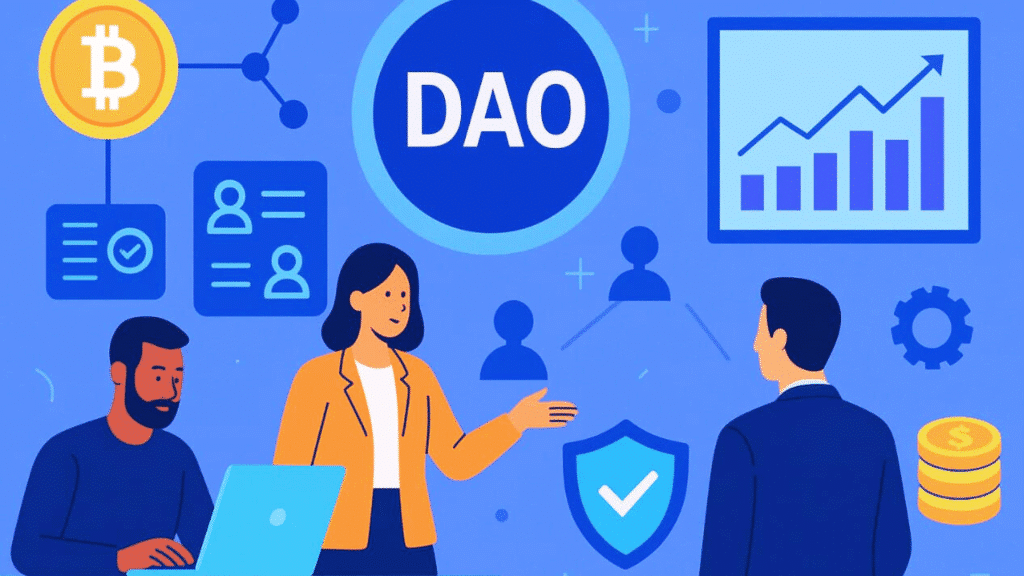The future of work in Web3 is beginning to reshape how individuals, businesses, and entire economies function. This change is being powered by blockchain, decentralized networks, and token based incentives.
- What is Work in Web3?
- How Are Tokenized Incentives Transforming Careers?
- How Are DAOs Reshaping Organizational Structures?
- What Role Do Credentials and Identity Play in Web3 Work?
- How Does Web3 Promote Inclusion and Global Participation?
- What Are the Main Challenges Facing Web3 Work?
- How Are Market Developments Shaping the Future of Work in Web3?
- Expanding Global Web3 Market and AI Integration
- How Should Professionals and Organizations Prepare?
- Conclusion
- Glossary
- Frequently Aksed Questions About Future Of Work in Web3
Web3 work is no longer just an experiment, it’s becoming a normal way to collaborate and grow careers. Professionals and organizations are figuring out new ways to adapt, take risks, and make the most of the opportunities this world offers.
Experts highlight that the Web3 blockchain market is set to skyrocket from just over $6.5 billion in 2025 to a remarkable $226 billion by 9 years. It’s clear that this technology is no longer operating at the fringes. The data isn’t just about exponential growth; it signals a fundamental shift in how we work and innovate worldwide.
What is Work in Web3?
Web3 is the future of the internet where authority is shared rather than being held by a handful of big companies. It uses blockchain and decentralized networks as the medium for people to interact with each other directly and decide collectively.
Compared to the previous Web, Web3 gives users the power to participate in the economy through tokens, rather than leaving decisions solely to platforms. As a result, the concept of work is being redefined.
Professionals take part in projects within decentralized autonomous organizations (DAOs), work on smart contract development, or help design token based economies, often collaborating remotely across the world.
The future of work in Web3 focuses on transparency, flexibility, and rewards based on merit, marking a major shift from traditional ways of working.
How Are Tokenized Incentives Transforming Careers?
Tokenized rewards are now a key part of working in Web3. Unlike regular salary systems, contributors have the opportunity to get tokens, royalties, or stake like rewards based on their work.

Such methods motivate people to make significant contributions, tie individual efforts to the project’s success, and give people a real share in decentralized ventures. Token rewards let professionals work on specific projects without having to move or go through long hiring processes.
Experts say that token based models are creating demand for specialized roles like smart contract developers, security auditors, tokenomics strategists, and decentralized product managers.
Working with teams spread across the world while earning real digital assets shows why the future of work in Web3 is changing how people collaborate. It makes work more flexible, fair, and open to anyone with the right skills.
How Are DAOs Reshaping Organizational Structures?
Decentralized Autonomous Organizations, or DAOs, are becoming the next model of working, very different from traditional ways. In these setups, decisions, voting, and fund distribution are all handled by token holders.
Unlike regular hierarchies, DAOs allow contributors to join projects, work toward clear goals, and get paid based on the results they achieve. This approach gives more freedom and makes work more transparent.
This governance model through tokens allows for a smoother inflow of skilled professionals and reduces hiring obstacles compared to traditional methods. Freelancers and small teams can join bigger projects without any hassle, forming networks that are easy to work in.
Many professionals see DAOs as a sign of how the future of work in Web3 is moving toward more decentralized and team based ways of working. These organizations are run openly, with clear rules, so everyone’s contributions are seen and treated fairly.
What Role Do Credentials and Identity Play in Web3 Work?
Web3 credentials provide secure and portable records of skills, certificates, and work contributions. For freelancers and contractors, they make it easier to prove their experience across different projects and platforms.
This helps build trust and makes working with others simpler. By combining on chain activity with verifiable achievements, people can clearly show what they have accomplished.
Professionals can show a verified record of their work beyond one employer, which makes it easier to move between projects and opportunities. Experts say this helps create a more flexible talent market and supports the growth of decentralized ways of working.
Because of this, portable credentials and digital identity become key for the future of work in Web3, where trust and verification take the place of traditional HR processes.
How Does Web3 Promote Inclusion and Global Participation?
Web3 work models are removing traditional geographic and social barriers. Token based participation lets people from all over the world join global projects without having to move.
Collaboration between teams across the world allows people with different skills to contribute to the same project. Token ownership lets contributors benefit from their work and helps include talent that might otherwise be overlooked.
Simple training and easy ways to join new projects help even more people take part. This shows that the future of work in Web3 isn’t just about decentralization,it’s about making work open to everyone.
What Are the Main Challenges Facing Web3 Work?
Even with its potential, the future of work in Web3 faces challenges. Unclear regulations, especially around token pay, worker classification, and international taxes, remain a concern.
Companies and workers need to navigate these rules carefully to manage risk. Companies and contributors need to work with legal rules to reduce risk. Security and identity management are also important.
In order to keep trust decentralized systems require audits and standard identity checks, and interoperability is crucial to overcome differences across chains and wallets. Division of the chains, wallets, and protocols for different purposes may slow down collaborations therefore, interoperability is necessary.
Token based pay can be unstable, so some projects combine fixed salaries with token rewards to give contributors more stability. Experts say solving these challenges is key to the long term success of decentralized work.
How Are Market Developments Shaping the Future of Work in Web3?
Web3 work ecosystems are becoming more developed. Rules are slowly being set up, giving legal support to token based work and decentralized jobs. AI is being used to help manage governance, match talent to projects, and organize work.
Tokenization is now being applied to real world products and services, opening up new ways to share value. This shows that the future of work in Web3 can offer fair, transparent, and measurable opportunities for both professionals and organizations.
Expanding Global Web3 Market and AI Integration
The Web3 blockchain market worldwide is expanding rapidly and is expected to rise from 6.57 billion USD in 2025 to around 226.4 billion USD by 2034. It includes technologies and platforms built on blockchain, such as public and private blockchains, decentralized apps, token systems, DeFi, NFTs, and decentralized identity solutions.
In 2025, over 17,000 AI agents were added to Web3 platforms, handling 4.5 million active wallets every day and making up 19% of Web3 activity. Globally, the use of cryptocurrencies and Web3 tools is done by more than 560 million people.
Projections indicate that the figure might increase to more than 1.5 billion by 2030, which is indicative of the substantial expansion and the increasing acceptance of the Web3 ecosystem.
How Should Professionals and Organizations Prepare?
The future of work in Web3 requires skills in smart contracts, tokenomics, and DAO governance. Professionals also need to understand regulations and work well with others to succeed.
Building on chain reputation and verifiable credentials provides a competitive edge. Organizations need transparent governance, strong security, and hybrid compensation models to support growth and reduce onboarding friction.
Conclusion
The future of work in Web3 is becoming real, with people working together through tokens, decentralized systems, and global teams. It brings more inclusivity, flexible work, and new ways to reward contributions.
Challenges like unclear rules, security issues, and unpredictable pay remain, but focusing on good governance, strong security, and verified credentials can help people and organizations succeed.
Glossary
Tokenized Incentives: Digital tokens given for work or project contributions.
Digital Credentials: Verified online records of skills or achievements.
Portable Reputation: Blockchain based proof of work that moves with you.
Decentralized Work: Global teamwork without central managers using Web3 tools.
DAO: Blockchain group where members vote and earn rewards independently.
Frequently Aksed Questions About Future Of Work in Web3
What is the future of work in Web3?
The future of work in Web3 is working through blockchain and tokens where people can join projects and collaborate from anywhere in the world.
How is Web3 different from the old internet?
Web3 lets users control decisions and earn through tokens instead of leaving power only to big companies or platforms.
How do token rewards affect careers?
Token rewards give people real value for their work, make jobs flexible, and let them join global projects without moving.
How do DAOs change traditional work structures?
DAOs remove bosses, let people work on projects freely, and pay them based on results instead of fixed salaries.
What skills are in demand for Web3 jobs?
Jobs need skills like smart contract coding, security checks, token economy planning, and managing decentralized products.



















































































































